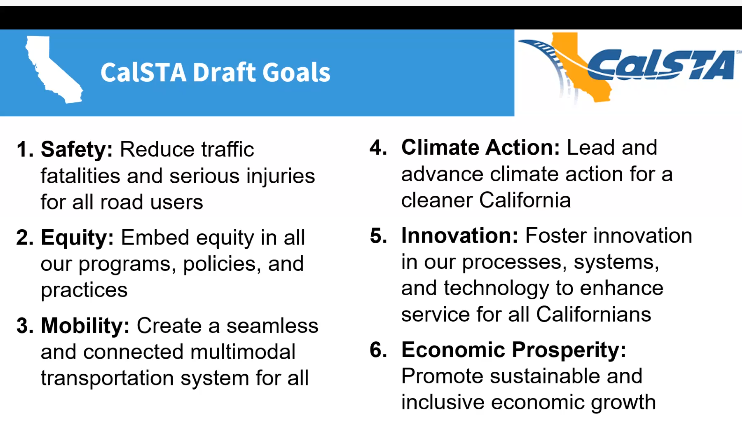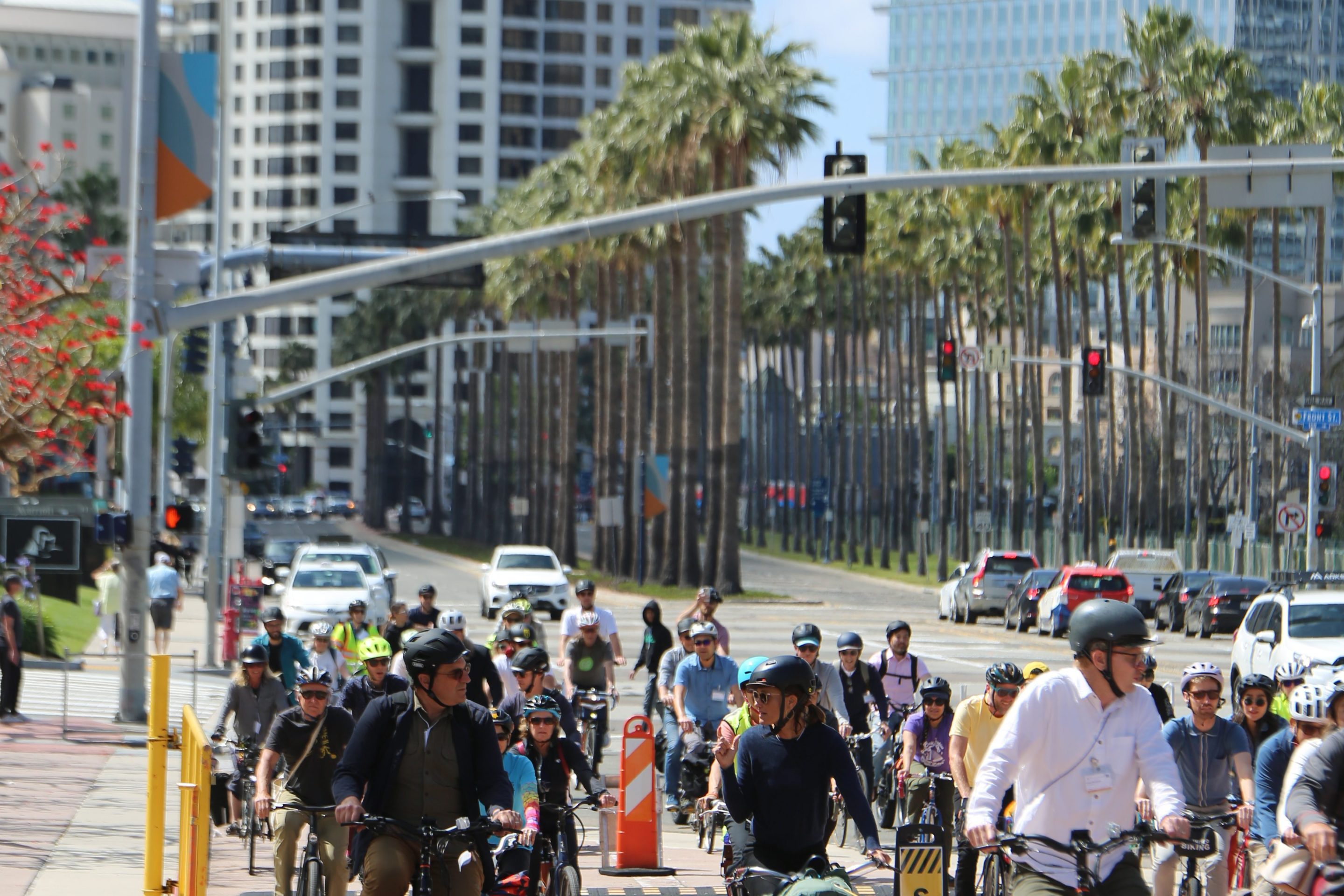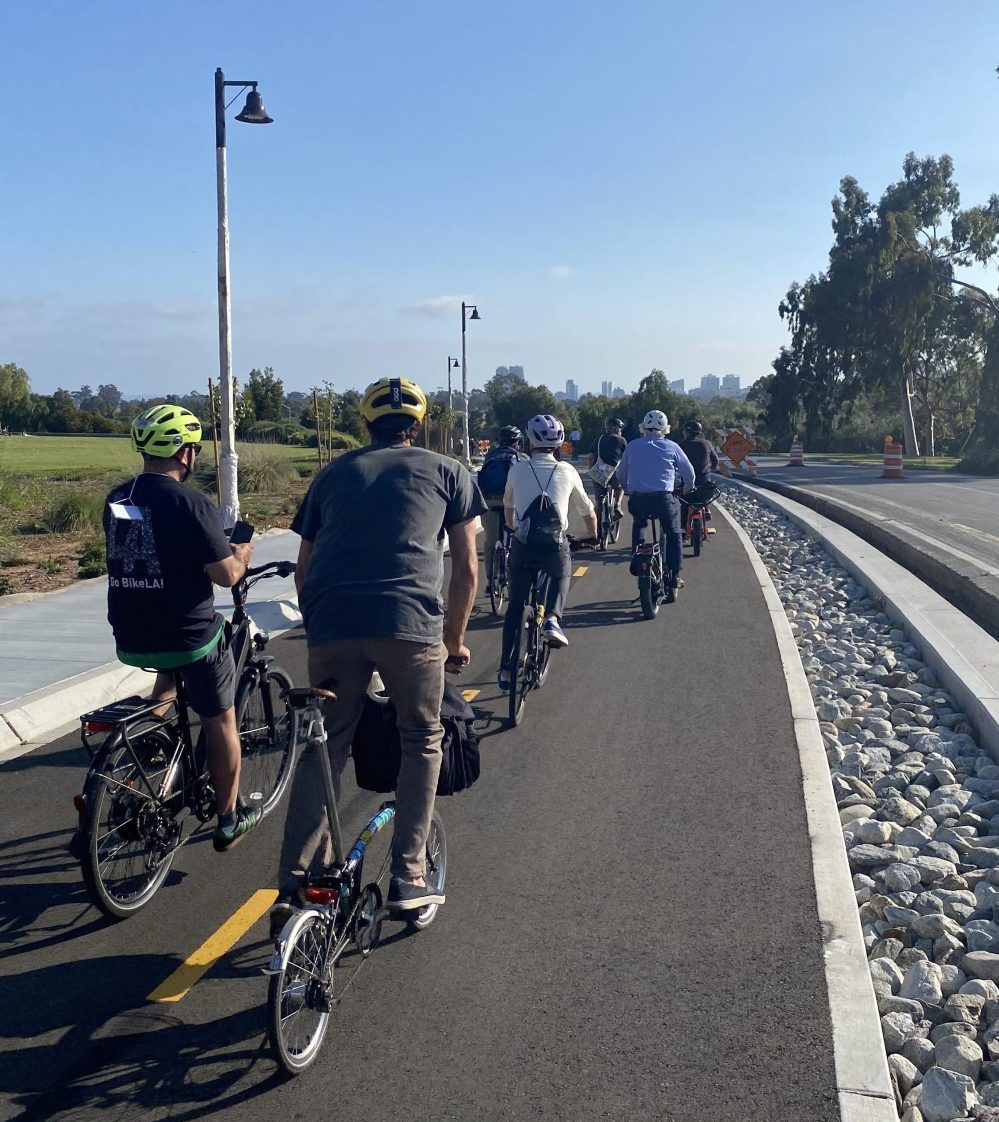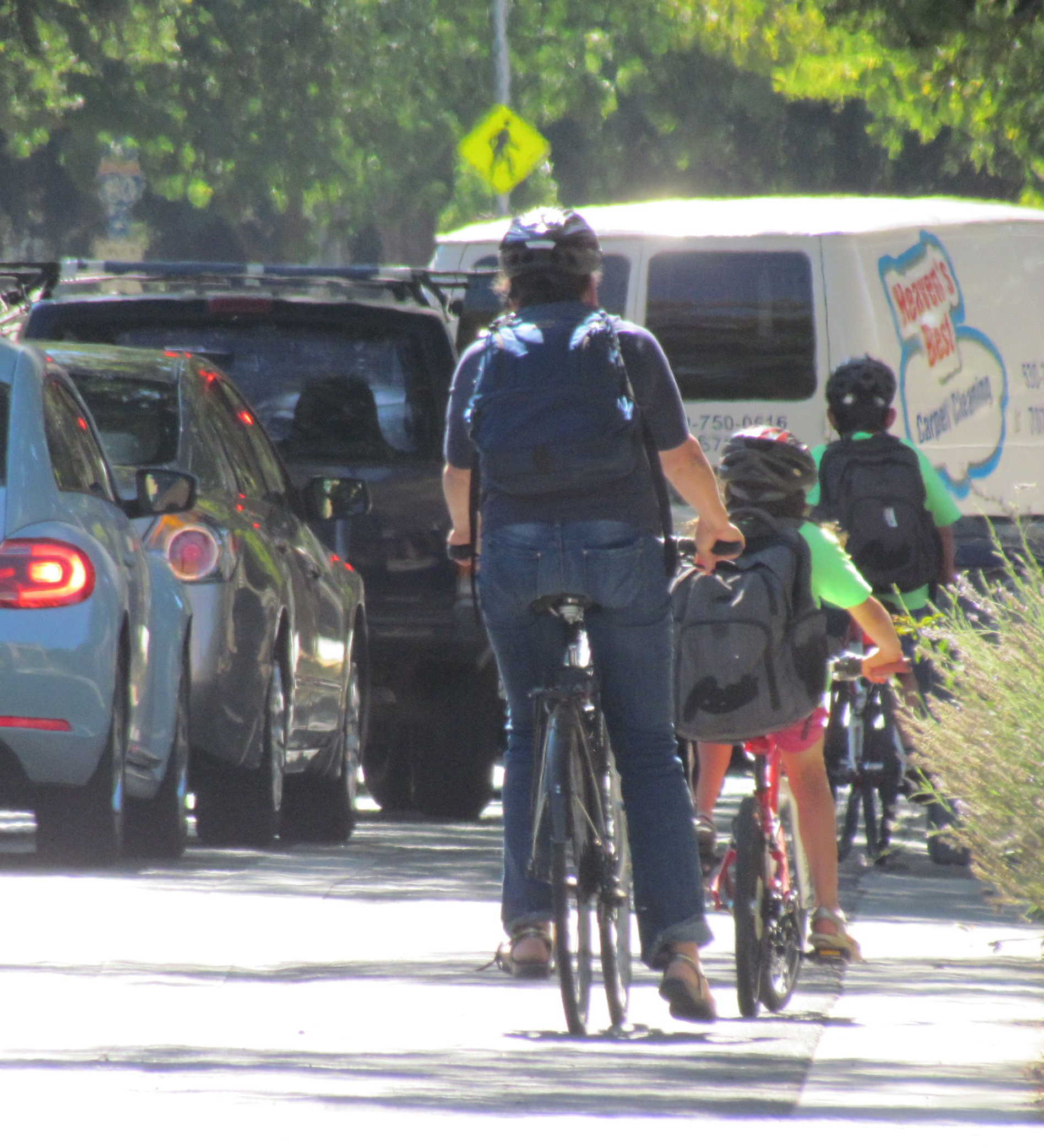A Strategic Plan for Future State Transportation Policy
The California State Transportation Agency (CalSTA) is currently creating its first strategic plan, and asking for input from the public.
4:02 PM PST on December 5, 2023

CalSTA Draft Strategic Plan
Note: GJEL Accident Attorneys regularly sponsors coverage on Streetsblog San Francisco and Streetsblog California. Unless noted in the story, GJEL Accident Attorneys is not consulted for the content or editorial direction of the sponsored content.
The California State Transportation Agency (CalSTA) is currently creating its first strategic plan, and asking for input from the public.
CalSTA is the umbrella agency created by Governor Jerry Brown to oversee the various departments and decision-making entities in the state. Those include the Department of Motor Vehicles, Caltrans, California Highway Patrol, California Transportation Commission, California High-Speed Rail Authority, California Office of Traffic Safety, the State Board of Pilot Commissioners, and the New Motor Vehicle Board.
That means that this new strategic plan should form the basis for all of the other department's planning, policy, construction, and other activities going forward - so getting it right is crucial.
CalSTA has been hosting a series of webinars to present and discuss the strategic plan, gather feedback, and discuss any potential changes before the release of the plan sometime in January 2024. The last webinar will be held tomorrow, Wednesday, December 6 from noon to 1:30 or so, and preregistration is necessary.
Feedback can also be submitted - by December 20 - to wehearyou [at] calsta.ca.gov
Note first that the strategic plan follows the outline of many strategic plans, naming a Mission (Why do we exist?), Vision (Where are we headed?), Goals (What will we achieve?) and Objectives (How will we get there?). But where most strategic plans would lead to a set of action plans, this one ends here because the implementation of these objectives is to be carried out by the departments under CalSTA's guidance.
Some of those departments - Caltrans, for instance - have undergone their own strategic planning process, which should be informed and underpinned by CalSTA's work going forward.
Streetsblog California attended one of the webinars recently. Below is a summary of the current draft plan and notes from some of the discussions that took place in that webinar.
California State Transportation Agency Strategic Plan
Vision: Whoever you are, wherever you live, we empower every person with safe, affordable, and clean transportation choices throughout CA
Mission: We lead people-first transportation programs and policies to enhance safety, equity, climate action, and economic prosperity for all Californians
This mission statement incorporates what CalSTA staff called the "core four" principles underpinning their work. Two other principles are important: mobility and innovation. One question asked by staffers is whether people think they should be added to the agency's mission statement.
The mission stems from the agency's core values, defined as focusing on:
- People First
- Inclusivity
- Collaboration
- Accountability
- Passion
The idea of being "people first" shows up in several places in this plan, said CalSTA staffer Stephanie Dougherty. "This is in recognition that transportation is above all about people and getting them where they need to be; it also is a reminder that CalSTA is one of the faces of government, and we want to advance opportunities for meaningful public engagement."
One webinar participant suggested that "sustainability" ought to be added to the list.
The agency's draft goals currently fall under six categories, pending further input and review. They are:
- Safety: Reduce traffic fatalities and serious road injuries for all users
- Equity: Embed equity in all our programs, policies, and practices
- Mobility: Create a seamless and connected multimodal transportation system for all Californians
- Climate Action: Lead and advance climate action for a cleaner California
- Innovation: Foster Innovation in our processes, systems, and technology to enhance service for all Californians
- Economic Prosperity: Promote sustainable and inclusive economic growth
They are all supposed to be "SMART" goals, i.e. specific, measurable, attainable, relevant, and time-bound. "CalSTA focused mostly on the first three aspects," said Dougherty, "with the last two being more relevant to the work of other agencies."
Under the overarching Safety goal, draft objectives are:
- Advance departmental initiatives to expand and enhance data quality, availability, and timeliness.
- Advocate for a strong safety culture in our departments and communities that focuses on the Safe System Approach.
- Collaborate and partner with stakeholders to identify, evaluate, and implement advanced traffic safety technologies and initiatives.
- Advance inter-agency collaboration and maximize the use of proven countermeasures targeted at our most significant traffic safety problems, including impaired driving, excessive/aggressive speed, and vulnerable road users.
- Enhance employee safety and wellness.
Equity:
- Increased disadvantaged business participation in federal contracts and small business access to state procurement and contracting opportunities.
- Create opportunities for meaningful community engagement in our planning, programming, and project design decisions to maximize community input and benefits, while recognizing the language access needs of our diverse communities.
- Increase tribal government access to transportation programs.
- Reconnect communities that have been harmed by past transportation decisions.
- Recruit and retain a diverse state workforce that is representative of all California's communities.
- Lead an Agency Community of Practice committed to diversity, equity, inclusion, and accessibility.
Mobility:
- Create a resilient high-speed rail system that connects to all other mobility options and easy access to jobs and housing.
- Lead the effort to integrate transit fare systems to allow seamless transit options across the state among regions and operators.
- Explore initiatives that more efficiently manage the existing highway system, prioritize the movement of transit, and better addressed negative impact of vehicle travel.
- Support the long-term viability of public transit through convening a transit transformation task force.
Climate Action:
- Focus on transportation as a climate strategy to reduce dependence on driving, lower vehicle miles traveled, and decrease the impact on land use.
- Support California's transition to decarbonize transportation through the adoption of zero emission technologies and the empowerment of all Californians to benefit from these advancements.
- Expand and strengthen California's influence as a global leader in clean transportation by developing significant relationships and agreements both domestically and abroad that advance climate action.
- Create a more resilient state transportation system.
Innovation:
- Support mobility innovations that have the potential to improve our transportation system.
- Bring services and programs closer to Californians through expanded and accessible digital services.
- Evaluate programs and projects to insure funding and assets are creating the greatest public benefit.
- Promote implementation of innovative data analytics and visualization tools to enhance decision-making processes and inform data-driven choices for transportation projects and policy development.
Economic Prosperity:
- Enhance supply chain resiliency, capacity, and efficiency and support research and development to implement innovative clean freight technologies.
- Strengthen the workforce pipeline to deliver billions of dollars worth of multimodal transportation and other infrastructure projects.
- Collaborate with federal and state partners to advance high road construction careers.
- Connect all Californians by expanding access to high-speed internet.
Are these the right goals and objectives? Are there any missing that should be included? These are the questions CalSTA staff is looking for answers to.
Feedback at Tuesday's webinar included suggestions to specify micromobility, Complete Streets, and vulnerable users within the safety and mobility objectives. Transit purpose is just as important as service type or geography, and high-speed rail is important but not the only form of interregional travel that needs attention, according to several commenters including yours truly.
Other comments urged a stronger focus on enhanced coordination and collaboration with other agencies, without which these objectives will never be met.
One participant urged that "there should be some kind of recognition of the unique climate challenge in the transportation system, given its currently the largest contributor to greenhouse gas emissions."
And another pointed out that the objectives need "a strong focus on VMT reduction through rethinking the way we invest in our state highway system, such as acknowledging that highway widenings do not result in reduction in congestion."
Another participant brought up emergency management planning. "I think considering issues like potential gasoline shortages, utility grid outages, and other unforeseen issues that could arise that should have plans developed around mitigating against those events should be included in CalSTA's strategic plans," they wrote.
And another added: "Spot-on. If included in the strategic plan, I'd want to elevate that public transit plays a critical role in emergency management/ response, and that providing transit agencies with funding for resiliency, infrastructure redundancies (for electrification) and priority to electricity, will be critical if we are to carry out our general service objectives and emergency response functions when natural/human-made disasters arise."
What are your thoughts? This kind of strategic plan can seem vague and not very action-oriented, but its usefulness in guiding agency plans and policies is important. Of course, that likely means continued advocacy to get agencies to live by their own strategic plans - but without a plan in the first place there is less to hold them accountable for.
Submit comments by December 20 to wehearyou [at] calsta.ca.gov
Streetsblog California editor Melanie Curry has been thinking about transportation, and how to improve conditions for bicyclists, ever since commuting to school by bike long before bike lanes were a thing. She was Managing Editor at the East Bay Express, editor of Access Magazine for the University of California Transportation Center, and earned her Masters in City Planning from UC Berkeley.
Stay in touch
Sign up for our free newsletter
More from Streetsblog California
Metro Board Funds Free Student Transit Pass Program through July 2025
Metro student free passes funded another year - plus other updates from today's Metro board meeting
Commentary: There is Zero Ambiguity to the West Portal Tragedy
What happened in West Portal was entirely predictable and preventable. The city must now close Ulloa to through traffic and make sure it can never happen again
Friday’s Headlines
Inspiration from the Bike Summit; OakDOT proposes standards for temporary safety upgrades; San Diego transforms a fast road in Balboa Park; Stockton transit funding is under threat; More
Active Transportation Program Calls for Volunteer Evaluators
Apply to be a volunteer ATP application evaluator by May 10.




